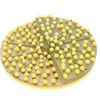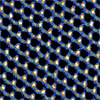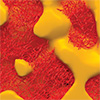Showing Spotlights 33 - 40 of 643 in category All (newest first):
 Researchers developed an innovative biomimetic technique enabling swift electrostatic assembly of functional nanoparticle monolayers across entire silicon wafers within seconds, over 100-1000 times faster than previous methods.
Researchers developed an innovative biomimetic technique enabling swift electrostatic assembly of functional nanoparticle monolayers across entire silicon wafers within seconds, over 100-1000 times faster than previous methods.
Feb 9th, 2024
 AI vision may become faster cheaper and more human-like with new perovskite synapses These mimic the retina's image processing for incredible efficiency.
AI vision may become faster cheaper and more human-like with new perovskite synapses These mimic the retina's image processing for incredible efficiency.
Feb 8th, 2024
 Researchers develop a technique to reliably grow high quality, wafer-scale sheets of promising 2D materials like graphene and boron nitride directly onto the non-conductive surfaces crucial for modern electronics manufacturing.
Researchers develop a technique to reliably grow high quality, wafer-scale sheets of promising 2D materials like graphene and boron nitride directly onto the non-conductive surfaces crucial for modern electronics manufacturing.
Feb 6th, 2024
 Cutting-edge research harnesses butterfly mating behaviors to create a groundbreaking visuochemical integration platform. This bio-inspired hardware, merging visual and chemical data, paves the way for advanced multisensory decision-making in artificial intelligence.
Cutting-edge research harnesses butterfly mating behaviors to create a groundbreaking visuochemical integration platform. This bio-inspired hardware, merging visual and chemical data, paves the way for advanced multisensory decision-making in artificial intelligence.
Feb 2nd, 2024
 Researchers have developed a low-temperature plasma method to produce mesoporous metal oxides, overcoming challenges that have limited integration in flexible electronics.
Researchers have developed a low-temperature plasma method to produce mesoporous metal oxides, overcoming challenges that have limited integration in flexible electronics.
Feb 1st, 2024
 Highly adaptable optothermal nanotweezers leverage thermophoresis and thermo-osmosis to trap nanoparticles as small as 3.3 nm across materials without requiring surface modifications.
Highly adaptable optothermal nanotweezers leverage thermophoresis and thermo-osmosis to trap nanoparticles as small as 3.3 nm across materials without requiring surface modifications.
Jan 29th, 2024
 Scientists leverage 'living' chemistry to 3D print intricate structures with unprecedented reversible shape and property changes over time, exhibiting complex, lifelike adaptation.
Scientists leverage 'living' chemistry to 3D print intricate structures with unprecedented reversible shape and property changes over time, exhibiting complex, lifelike adaptation.
Jan 26th, 2024
 Liquid crystal polymer networks enable light-controlled transfer, sensing and reactions of chemical messengers between layers of robotic skin, showcasing new possibilities for adaptive responses and multi-agent coordination.
Liquid crystal polymer networks enable light-controlled transfer, sensing and reactions of chemical messengers between layers of robotic skin, showcasing new possibilities for adaptive responses and multi-agent coordination.
Jan 24th, 2024
 Researchers developed an innovative biomimetic technique enabling swift electrostatic assembly of functional nanoparticle monolayers across entire silicon wafers within seconds, over 100-1000 times faster than previous methods.
Researchers developed an innovative biomimetic technique enabling swift electrostatic assembly of functional nanoparticle monolayers across entire silicon wafers within seconds, over 100-1000 times faster than previous methods.
 Subscribe to our Nanotechnology Spotlight feed
Subscribe to our Nanotechnology Spotlight feed





